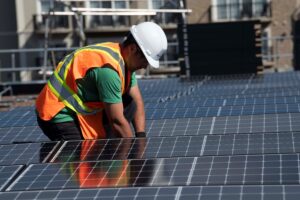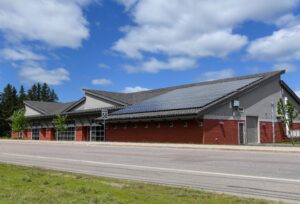Siemens Better Integrates Customer and Utility-scale Solar

Projects Sponsor
Innovative Smart Grid technology helps the Shediac Smart Energy Community Project drive the future of energy.
The energy transition opens the door to decarbonizing the global energy sector for future generations; but innovation, by its very nature, brings challenges. Siemens Canada understands that with each of these challenges comes an opportunity and with their Shediac Smart Energy Community Project, they set out to learn from their not-mistakes.

The Shediac project, which was launched in 2018 and will continue until 2024, is designed to explore and address a number of issues presented by our increasing reliance on solar and wind energy — and there are issues.
The intermittent nature of renewable energy sources makes balancing supply and demand tricky. System operators are sometimes forced to purchase expensive peak power to meet demand, leading to higher prices for consumers. Transition to renewables may impact system reliability, requiring increased grid upgrades, further raising energy prices.
At the same time, excess renewable capacity during periods of low demand can lead to negative prices, impacting the return on investment for base-load providers.
As the number of extreme weather events increases, ageing transmission and distribution equipment require more and more significant repair. This means localized investments in renewables and storage can be more cost-effective than traditional system upgrades. This disrupts the market; prosumers generating and consuming their own electricity, means traditional utilities face load defection. Without regulatory frameworks and utilities engaging with their changing customer base, end-users may prioritize individual optimization, missing out on system-wide efficiencies.
Addressing these challenges requires planning, regulatory reforms, and a collaborative ecosystem across the energy value chain, including governments, policymakers, corporations, and research institutes. The use of innovative technologies and digitalization will also play a significant role in facilitating the energy transition.
Fortunately, all of these elements were brought into play for the Shediac Smart Energy Community Project, and they played well.
In collaboration with NB Power, the Town of Shediac, and with government funding, Siemens implemented an innovative Smart Grid technology R&D project. The Energy System Platform (ESP) developed by Siemens serves as the heart of the initiative.

A cloud-based platform for energy, ESP, connects to a wide array of energy resources such as batteries, solar, EV chargers, and even entire microgrids, to efficiently optimize the demand and supply of energy grids. The ESP effectively manages distributed energy resources by integrating utility-scale solar and storage, as well as customer-owned solar, storage, and smart home technologies.
The goals for Shediac also included achieving net-zero certification for two important Shediac buildings – the Shediac Multipurpose Centre and the Government of Canada Pension Centre. Solar panels and battery energy storage were added and energy efficiency upgrades were completed. These buildings will use energy produced from NB Power’s first grid-connected, 1.63-megawatt solar farm, becoming New Brunswick’s first net-zero commercial buildings, with excess electricity flowing into the community via the distribution system.

As part of the project, Siemens partnered with 400 Shediac homeowners to install and test energy technology that includes solar and battery energy storage systems, and smart thermostats.
Throughout the program, the Siemens team worked to better understand customer attitudes and perceptions related to participation in decentralized energy programs and determine how customer consumption patterns and utility costs change under time-of-day rates; those goals were met.
By creating and showcasing a grid of the future using real-life assets in smart energy communities, the project aims to enable an efficient and cost-effective energy transition. The project has successfully achieved net-zero emissions for a large government facility, the Shediac Pension Centre.
Additionally, the project has delivered measurable cost savings, demonstrating the economic benefits of transitioning to clean energy sources and implementing advanced grid management technologies.
During the power outage caused by Tropical Storm Fiona, it was evident which homes were part of the project as they were the ones that kept their lights on. These homes that had received solar and battery storage experienced no loss of power, while grid restoration activities took several days to complete. This real-world scenario showcases the resilience and reliability provided by the project, making a tangible difference in the lives of community members and underscoring the importance of such initiatives in building resilient energy systems.
Siemens’ work in Shediac has the potential to significantly impact the global energy transition. It’s just a small-town grid living in our only world and that has a lot of people believing.













